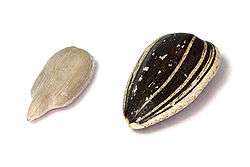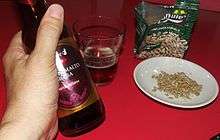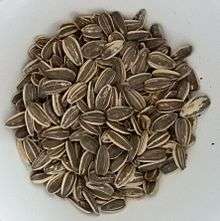Sunflower seed

The sunflower seed is the fruit of the sunflower (Helianthus annuus). The term "sunflower seed" is actually a misnomer when applied to the seed in its pericarp (hull). Botanically speaking, it is a cypsela. When dehulled, the edible remainder is called the sunflower kernel or heart.
There are three types of commonly used sunflower seeds: linoleic (most common), high oleic, and NuSun. Each variety has its own unique levels of monounsaturated, saturated, and polyunsaturated fats. The information in this article refers mainly to the linoleic variety.
For commercial purposes, sunflower seeds are usually classified by the pattern on their husks. If the husk is solid black, the seeds are called black oil sunflower seeds. The crops may be referred to as oilseed sunflower crops. These seeds are usually pressed to extract their oil. Striped sunflower seeds are primarily used for food; as a result, they may be called confectionery sunflower seeds.
| Sunflower seed production – 2013 | |
|---|---|
| Country | Production (millions of tonnes) |
| | |
| | |
| | |
| | |
| | |
| | |
Cultivation
In 2013, world production of sunflower seeds was 44.5 million tonnes, with Ukraine and Russia accounting for half of the total (table).[1]
Uses

Food

.jpg)
Sunflower seeds are more commonly eaten as a snack than as part of a meal. They can also be used as garnishes or ingredients in various recipes. The seeds may be sold as in-shell seeds or dehulled kernels. The seeds can also be sprouted and eaten in salads.
When in-shell seeds are processed, they are first dried. Afterwards, they may also be roasted or dusted with salt or flour for preservation of flavor. Dehulling is commonly performed by cracking the hull with one's teeth and spitting it out while keeping the kernel in the mouth and eating it.
Sunflower seeds sold by the bag are either eaten "plain" (salted only) or with a variety of flavorings added by the maker including barbecue, pickle, hot sauce, bacon, ranch, and nacho cheese as well as others.
In-shell sunflower seeds are particularly popular in Mediterranean and Asian countries where they can be bought freshly roasted and are a common food, while in many countries, they can be bought freshly packed in various roasted flavors. In the United States, they are commonly eaten by baseball players as an alternative to chewing tobacco.[2]
Dehulled kernels have been mechanically processed to remove the hull. These kernels may be sold raw or roasted. These dehulled kernels are sometimes added to bread and other baked goods for their flavor. There is also sunflower butter, similar to peanut butter, but using sunflower seeds instead of peanuts, which is a common substitute in schools for children with nut allergies . Apart from human consumption, sunflower seeds are also used as food for pets and wild birds in boxes and small bags.
Hulls
The hulls, or shells, mostly composed of cellulose, decomposes slowly and may be burned as biomass fuel.[3] Sunflower hulls of the cultivated sunflower (Helianthus annuus) contain allelopathic compounds which are toxic to grasses and the vast majority of cultivated garden plants. The hulls can be used as an effective herbicide and will typically kill or severely stunt the growth of competing plants if used as mulch. Care should be observed in the placement of bird feeders in gardens with bird seed which contains sunflower seeds as the discarded hulls can end up scattered by birds or squirrels from feeders and can kill or stunt plants that are growing nearby. Only a small number of garden plants, such as day lillies, are unaffected by the allelopathic compounds found in sunflower hulls.[4][5]
Pressed oil
Over the past decades sunflower oil has become popular worldwide. The oil may be used as is, or may be processed into polyunsaturated margarines. The oil is typically extracted by applying great pressure to the sunflower seeds and collecting the oil. The protein-rich cake remaining after the seeds have been processed for oil is used as a livestock feed.
The original sunflower oil (linoleic sunflower oil) is high in polyunsaturated fatty acids (about 68% linoleic acid) and low in saturated fats, such as palmitic acid and stearic acid. However, various hybrids have been developed to alter the fatty acid profile of the crop for various purposes.[6]
| Nutritional value per 100 g (3.5 oz) | |
|---|---|
| Energy | 2,445 kJ (584 kcal) |
|
20 g | |
| Sugars | 2.62 g |
| Dietary fiber | 8.6 g |
|
51.46 g | |
| Saturated | 4.455 g |
| Monounsaturated | 18.528 g |
| Polyunsaturated | 23.137 g |
|
20.78 g | |
| Vitamins | |
| Thiamine (B1) |
(129%) 1.48 mg |
| Riboflavin (B2) |
(30%) 0.355 mg |
| Niacin (B3) |
(56%) 8.335 mg |
| Pantothenic acid (B5) |
(23%) 1.13 mg |
| Vitamin B6 |
(103%) 1.345 mg |
| Folate (B9) |
(57%) 227 μg |
| Choline |
(11%) 55.1 mg |
| Vitamin C |
(2%) 1.4 mg |
| Vitamin E |
(234%) 35.17 mg |
| Minerals | |
| Calcium |
(8%) 78 mg |
| Iron |
(40%) 5.25 mg |
| Magnesium |
(92%) 325 mg |
| Manganese |
(93%) 1.95 mg |
| Phosphorus |
(94%) 660 mg |
| Potassium |
(14%) 645 mg |
| Sodium |
(1%) 9 mg |
| Zinc |
(53%) 5 mg |
| Other constituents | |
| Water | 4.7 g |
|
| |
| |
| Percentages are roughly approximated using US recommendations for adults. | |
Nutritional value
In a 100-gram serving, dried whole sunflower seeds provide 584 calories and are composed of 5% water, 20% carbohydrates, 51% total fat and 21% protein (table). The seeds are a rich source (20% or higher of the Daily Value, DV) of protein (42% DV), dietary fiber (36% DV), many B vitamins (23-129% DV) and vitamin E (234% DV). The seeds also contain high levels of dietary minerals, including magnesium, manganese, phosphorus, iron and zinc (40-94% DV).
Half of a 100-gram serving is fat, mainly monounsaturated and polyunsaturated fats, principally linoleic acid. Additionally, the seeds contain phytosterols which may contribute toward lower levels of blood cholesterol.[7]
See also
| Wikimedia Commons has media related to Sunflower seeds. |
References
- 1 2 "Production/Crops, World, Sunflower seeds, Food and Agriculture Organization of the United Nations: Division of Statistics". UN Food and Agriculture Organization Corporate Statistical Database (FAOSTAT). 2013.
- ↑ Blount, Roy, Jr. "The Seeds Of Content." Sports Illustrated, 06 Oct. 1980. Web. 07 Oct. 2013.
- ↑ Zabaniotou, A.A; Kantarelis, Theodoropoulos (2008). "Sunflower shells utilization for energetic purposes in an integrated approach of energy crops: Laboratory study pyrolysis and kinetics". Bioresource Technology. 99 (8): 3174–3181. doi:10.1016/j.biortech.2007.05.060. PMID 17651967.
- ↑ Leather, Gerald R. (1987). "Weed control using allelopathic sunflowers and herbicide". Plant and Soil. 98: 17. doi:10.1007/BF02381723.
- ↑ Ciarka, D.; Gawronska, H.; Szawlowska, U.; Gawronski, S. W. (2009). "Allelopathic potential of sunflower. I. Effects of genotypes, organs and biomass partitioning". Allelopathy Journal. 23 (1): 95–109.
- ↑ "National Sunflower Association : Sunflower Oil". Sunflowernsa.com. Retrieved 2011-03-27.
- ↑ "Sunflower Seeds, Pistachios Among Top Nuts For Lowering Cholesterol". Science Daily. 7 December 2005. Retrieved 2011-03-27.